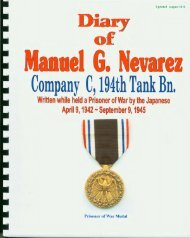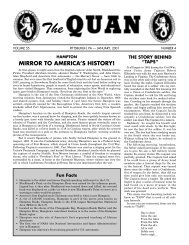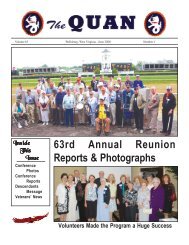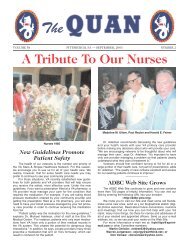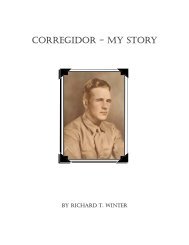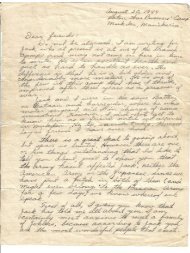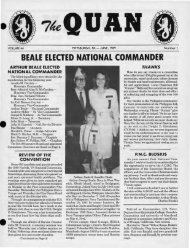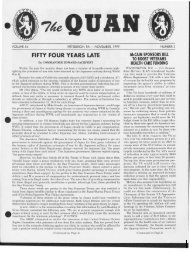June/July 2002 - Philippine Defenders Main
June/July 2002 - Philippine Defenders Main
June/July 2002 - Philippine Defenders Main
Create successful ePaper yourself
Turn your PDF publications into a flip-book with our unique Google optimized e-Paper software.
16 — THE QUAN<br />
<strong>Philippine</strong> Scouts’ Glory Days Recalled<br />
Unit’s claim to fame include helping stall Japan’s invasion of the islands in the early days of WWII.<br />
As Americans all over the world take<br />
time to remember veterans — both past<br />
and present — and their sacrifices for<br />
freedom, John E. Olson will remember the<br />
<strong>Philippine</strong> Scouts.<br />
Olson, a retired U.S. Army colonel living<br />
in San Antonio, has written two history<br />
books and a novel based on his research<br />
and experience as a Scout.<br />
The <strong>Philippine</strong> Scouts were created in<br />
1901 and existed only 50 years. But from<br />
the group’s formation in the wake of the<br />
Spanish-American War through its service<br />
in the darkest days of World War II, the<br />
little-known unit covered itself with glory.<br />
During its half-century of existence,<br />
three members of the <strong>Philippine</strong> Scouts<br />
received the Medal of Honor, the nation’s<br />
highest award for courage above and<br />
beyond the call of duty.<br />
Olson served in the Scouts’ 57th<br />
Infantry Regiment, a unit with roots that<br />
extended to Fort Sam Houston during<br />
World War I and the Civil War battle of<br />
Chickamauga in Georgia. Members of the<br />
regiment, which helped hold the Japanese<br />
at bay in the <strong>Philippine</strong>s, were awarded<br />
21 Distinguished Service Crosses and 68<br />
Silver Stars.<br />
Olson earned one of those Silver Stars<br />
for helping set up a command post after<br />
an artillery barrage. He also was among<br />
the <strong>Philippine</strong>s defenders who were captured<br />
and forced to participate in the infamous<br />
Bataan Death March. Only half of<br />
the 12,000 Scouts in the service at the<br />
start of World War II survived the conflict.<br />
“I’m particularly proud of my service<br />
with the <strong>Philippine</strong> Scouts,” says the 84year-old<br />
Olson, who serves as the historian<br />
of the <strong>Philippine</strong> Scouts Heritage<br />
Society. “It was a great outfit.”<br />
After the war, Congress quickly authorized<br />
the enlistment of 50,000 <strong>Philippine</strong><br />
Scouts to serve as occupation forces in<br />
Japan. Following the independence of the<br />
<strong>Philippine</strong>s in 1946, some of the original<br />
scouts took advantage of an opportunity to<br />
become American citizens and join other<br />
units in the U.S. Army. Two years later,<br />
most of the remaining <strong>Philippine</strong> Scouts<br />
on duty were those in hospitals, suffering<br />
from long-term illnesses.<br />
The <strong>Philippine</strong> Scouts were created to<br />
help quell an insurrection after Spanish<br />
armed forces left the islands, which had<br />
just become U.S. territory. Congress<br />
authorized the enlistment of 5,000<br />
Filipinos, who were divided into companies<br />
of 100 men, each led by an American<br />
officer.<br />
“We had to pacify the Filipinos,” Olson<br />
says. “In the <strong>Philippine</strong> Scouts, we used<br />
their own citizens, their own relatives and<br />
their own friends.”<br />
Olson’s father served two tours with the<br />
U.S. Army in the <strong>Philippine</strong>s in the early<br />
By DAVID UHLER, Express-News Staff Writer<br />
1900s. The father passed along a love of<br />
the country and its people to the son. After<br />
Olson graduated from West Point in 1939,<br />
he asked for and received a posting to the<br />
<strong>Philippine</strong> Scouts as his first assignment.<br />
Asia and the South pacific were already<br />
in turmoil. Japan, lacking many natural<br />
resources, had invaded Manchuria and<br />
had its sights set on other targets. Over<br />
the next two years, Olson participated in<br />
annual military maneuvers that were a<br />
dress rehearsal for an invasion that eventually<br />
came. Under “War Plan Orange,”<br />
the defenders of the <strong>Philippine</strong>s would be<br />
required to hold the invaders of for six<br />
months, long enough for the U.S. pacific<br />
Fleet to arrive with reinforcements.<br />
The war games became reality on Dec.<br />
7, 1941. Official word of the attack on<br />
Pearl Harbor arrived in the <strong>Philippine</strong>s<br />
early in the morning of Dec. 8.<br />
“By 8 a.m.,” Olson recalls, “we were combat-loaded<br />
and ready to go to our positions.”<br />
Japanese planes bombed an American<br />
airfield the next day and troops landed on<br />
the principal island, Luzon, a few days<br />
later. On paper, the defenders of the<br />
<strong>Philippine</strong>s appeared to have the upper<br />
hand. Besides the <strong>Philippine</strong> Scouts and<br />
other U.S. Army units, they had the<br />
<strong>Philippine</strong> Army, more than 120,000<br />
strong. Most of those troops, however,<br />
were equipped with old rifles from World<br />
War I plus small-caliber machine guns:<br />
they lacked mortars.<br />
The defenders did the best they could.<br />
The Japanese thought they would roll<br />
over the islands in a few weeks. Instead,<br />
the defenders of Bataan and Corregidor<br />
didn’t surrender for five months, almost<br />
achieving the objective of “War Plan<br />
Orange.” Unfortunately, much of the<br />
Pacific Fleet, instead of rushing to the<br />
<strong>Philippine</strong>s with reinforcements, was<br />
lying on the bottom of Pearl Harbor.<br />
After Bataan fell, the Japanese forced<br />
about 70,000 American and Filipino<br />
defenders to walk 65 miles to a prisoner of<br />
war camp at the start of their captivity.<br />
Many of the POWs were malnourished and<br />
sick from malaria, dysentery and other<br />
tropical diseases. Only 54,000 men survived<br />
the march; between 7,000 and 10,000<br />
died. The rest escaped into the jungle.<br />
Olson, who didn’t get sick until after the<br />
march, survived by filling his canteen<br />
whenever he could and keeping out of<br />
reach of the Japanese, who often bayoneted<br />
or shot stragglers.<br />
One soldier tried to take Olson’s West<br />
Point class ring at bayonet point.<br />
“I was one of the lucky ones,” says<br />
Olson, who still has the well-worn gold<br />
ring. “I was in one of the first groups on<br />
the Death March.”<br />
Another <strong>Philippine</strong> Scout, Menandro<br />
Parazo, escaped after nine days on the<br />
trail. A native Filipino, Parazo joined a<br />
guerrilla unit and continued fighting. A<br />
year later, the Japanese captured him<br />
again and sent him to Fort Santiago, where<br />
Parazo says the enemy tortured prisoners.<br />
“Ninety-nine percent of the people never<br />
came out alive,” says the 84-year-old Parazo,<br />
who now lives in El Paso. “They make<br />
you drink water, and they step on your<br />
stomach. They burned my face with lighted<br />
cigarettes, and they beat me up.”<br />
Parazo escaped from Santiago after a<br />
few months and rejoined the guerrillas.<br />
When Gen. Douglas MacArthur and the<br />
Americans returned to the <strong>Philippine</strong>s in<br />
early 1945, Parazo rejoined U.S. forces and<br />
participated in the liberation of Manila. He<br />
later received a direct commission to the<br />
U.S. Army as second lieutenant. After duty<br />
in Japan and the United States, Parazo<br />
retired as a captain in 1971.<br />
Olson spent most of the war in Japan.<br />
In November 1942, Olson was transported<br />
to Manila, where he and 1,500 other<br />
American POWs boarded the Nagata<br />
Maru, a freighter bound for Japan. Fifteen<br />
men died during the 19-day journey.<br />
Once again Olson was lucky. Many other<br />
POWs transported later in the war were<br />
forced to board “hell ships” and live for days<br />
without food or water. Thousands died.<br />
In Japan, Olson worked with other<br />
POWs in a factory that produced steel<br />
drums. They lived on rice and soup, mostly<br />
turnips supplemented by an occasional<br />
piece of meat, and dreamed about home.<br />
For entertainment, the American prisoners<br />
— many of whom had never cooked<br />
a meal in their lives — often wrote and<br />
exchanged recipes with each other, like a<br />
bunch of kids trading baseball cards.<br />
Caroline Burkhart, the daughter of a former<br />
<strong>Philippine</strong> Scout, found dozens of the<br />
handwritten recipes last year among the<br />
wartime memorabilia left by her father.<br />
Thomas F. Burkhart didn’t talk much<br />
about his experiences during the war. He<br />
died in 1972. Most of what his daughter<br />
knows is from information she and her sister<br />
have pieced together from journals he<br />
kept during his years in captivity. He<br />
earned a Silver Star for helping save a<br />
Filipino sergeant who had been wounded.<br />
Burkhart’s curiosity about her father’s<br />
military past led her to San Antonio<br />
recently for a convention of the American<br />
<strong>Defenders</strong> of Bataan and Corregidor, a<br />
group of veterans that also includes some<br />
former <strong>Philippine</strong> Scouts.<br />
Burkhart, who lives in Baltimore, spent<br />
several days sightseeing, attending seminars<br />
about the war and talking to World<br />
War II veterans.<br />
“One little man I was sitting with downstairs<br />
said, ‘If you’re a child of one of us,<br />
you’re one of us,’ ” Burkhart recalled. “I<br />
almost cried.”



